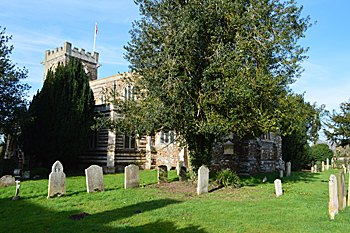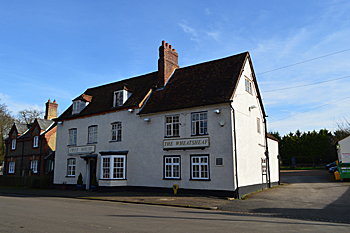A Riot in Tempsford

The church from the south-east February 2016
In January 1839 the Bedfordshire Quarter Sessions tried fourteen Tempsford residents charged with contributing to riots that broke out on the 5th and 6th of June in the previous year. The case, reported the Bedfordshire Mercury on 12th January 1839, “excited much interest, the court being crowded the whole time of the trial, which lasted from 10 in the morning till half past five in the evening”. Public interest in the case was sparked by the fact that amongst the defendants were a number of well-known and respected gentlemen farmers. The accused were:
- Thomas Taylor, landlord of the Wheatsheaf
- John Allen, farmer
- John Browning the elder, corn factor
- Cain Ashfield (or Ashford), farmer
- Joseph Addington, yeoman
- Thomas Mobbs, farmer
- Joseph Stokes, labourer
- James Mills (or Miles), labourer
- Jabez Auton (or Acton), labourer
- Joseph Audley , labourer
- Catherine Bennett, spinster
- Mary Baldock, spinster
- Sarah, wife of William Medlock
- Mary Stratton, spinster
The riot had been sparked by rumours that the church was withholding charity from the poor. It had long been a tradition in Tempsford for the churchwardens to give bread to the needy each year on Whit Sunday and they had done so for as long as any of the local inhabitants could remember. On this particular occasion, however, the Archdeacon had instructed that a portion of the bread money be kept back to pay for church repairs. As the news became known around the village, the indignation of the poor and the prosperous alike was provoked and the two churchwardens were accused of deliberately keeping the bread money for themselves. Henry Tingey (or Tingay) and John Ashwell told the court that in the days leading up to the riots they had both been confronted by groups of angry villagers in the streets and at their homes.

The Wheatsheaf February 2016
Tingey told the court that on the 5th June he had been walking past the Wheatsheaf public house with the curate, Reverend Cotesworth, when they met a crowd of the accused men and women:
“[Thomas] Taylor said to me, “Tingey, you are guilty – we shall bring you in guilty – guilty!”… and threw his arms about in an awful manner. Mr Browning spoke to Mr Cotesworth, the effect of which made the mob shout and huzza. After I saw the manner of the people towards us I began to feel rather unpleasant, in danger that is. Some stones and dirt were thrown at us after the defendants had spoken and on our attempting to get away I was hurtled and pulled about by some people taking hold of my arms. Mr Coles came to my assistance and I got away over his fields and back away home”.
The following day the curate called a meeting at the school room where he hoped to read the Archdeacon’s letter aloud to the gathered poor, to show that the churchwardens were not to blame for withholding the bread. He told the court:
“[I] was going to the school for the purpose of reading the Archdeacon’s letter when [John] Browning called after [me] and said, “You are a bad fellow or you would not have acted so.” Taylor said, “Why do you have private meetings? Why not have them at the church? You told Mobbs we should not come to the school” and (using violent action) “You wish to wrong the poor!””
Ten men, including the farmers, were brought before the Quarter Sessions court in January charged with the 5th June assault on Tingey. A second charge of rioting was also brought against them because on the same night “they did make a Great Noise, riot and disturbance and did then and there remain and continue making such Noise, Riot and disturbance for the space of one hour and more …” (QSR1839/1/6/42). A second group, mainly labourers but including some of the same men, was charged with assaulting Tingey and for causing another disturbance on the following evening, a disturbance that lasted eight hours and saw villagers parading through the village streets with two lifelike human effigies headed for a bonfire.
The fact that the initial disturbance had been caused in defence of the village poor was a matter of some pride to the men involved. The Bedfordshire Times of 20th October 1838 reported that:
“Amongst the party accused are some of the oldest and most respectable farmers and some of the largest ratepayers in the parish. They had understood that their kind and respected landlord W. Stuart Esq, late MP for this county, would be present [in court] at which they expressed pleasure as they are most anxious for a public investigation of the facts and that Mr Stuart particularly should hear a faithful statement of them.”
Two more local farmers, Joseph Bennett and John Hull, gave their support by agreeing to be bound for £40 to secure the appearance of each of the fourteen accused men and women in court.
The ten men accused of the fray on the 5th June, pleaded not guilty and the verdict was returned in their favour. The second group, who took part in the more serious disturbance on the following day, switched to a guilty plea in the middle of the trial. They entered into their own recognizances and were discharged [QSM33]. Mr Smith, counsel for the defence, observed to the court in summing up that “if ever there was a case brought into court of a mountain in labour bringing forth a mouse, this was that case.”
Riots involving Tempsford church were not new. In 1832 a group of men had forced their way into the church and commenced an orgy of drinking, swearing and bell-ringing.